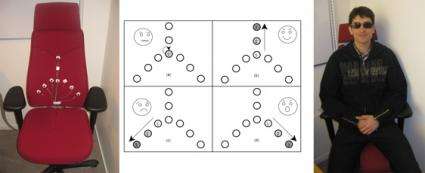New technology helps visually impaired to 'see' emotions

Without vision it's impossible to interpret facial expressions, or so it's believed. Not any more. Shafiq ur Rehman, Umea University, presents a new technology in his doctoral thesis - a Braille code of emotions. "It gives new opportunities for social interactions for the visually impaired," he says.
Lacking the sense of vision can be very limiting in a person's daily life. The most obvious limitation is probably the difficulty of navigation, but small details in everyday life, which seeing people take for granted, are also missed. One of those things is the ability to see a person during a conversation. Facial expressions provide emotional information and are important in communication. A smile shows pleasure, amusement, relief, etc. Missing information from facial expressions create barriers to social interactions.
“Blind persons compensate for missing information with other senses such as sound. But it is difficult to understand complex emotions with voice alone,” says Shafiq ur Réhman.
His thesis addresses a challenging problem: how to let visually impaired “see” others’ emotions. To make this possible the research group has developed a new technology based on an ordinary web camera, hardware as small as a coin, and a tactile display. This enables the visually impaired to directly interpret human emotions.
“Visual information is transferred from the camera into advanced vibrating patterns displayed on the skin. The vibrators are sequentially activated to provide dynamic information about what kind of emotion a person is expressing and the intensity of the emotion,” he explains.
The first step for a user is to learn the patterns of different facial expressions by using displaying the emotions in front of a camera that translates the emotions into vibrational patterns. In this learning phase the visually impaired person have a tactile display mounted on the back of a chair. When interacting with other people a sling on the forearm can be used instead.
The main research focus has been to characterise different emotions and to find a way to present them by means of advanced biomedical engineering and computer vision technologies. The project was founded by the Swedish Research Council.
The research group’s spin-off company Videoakt AB has been granted a patent for the technology, which soon will be available as a product on the open market. Tactile feedback is also interesting in other areas as a future communication tool, for seeing people as well.
“We have successfully demonstrated how the technology can be implemented on mobile phones for tactile rendering of live football games and human emotion information through vibrations. This is an interesting way to enhance the experience of mobile users,” explains Shafiq ur Réhman.
On Wednesday, 28 April, Shafiq ur Réhman, Department of Applied �鶹��Ժics and Electronics, Umeľ University, will defend his doctoral thesis, titled Expressing Emotions through Vibration.
Provided by Umea University















